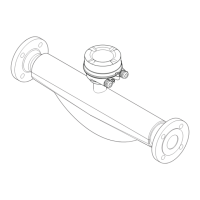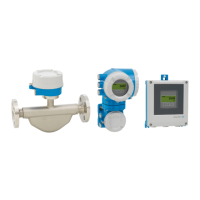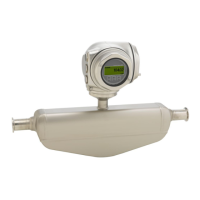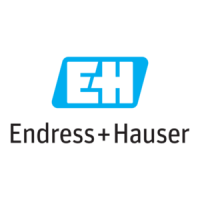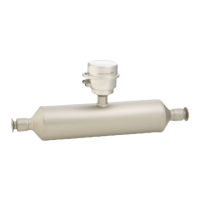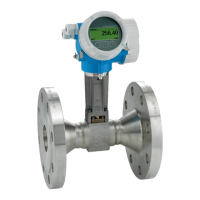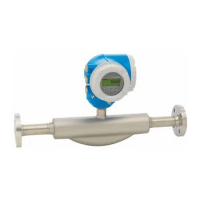
Do you have a question about the Endress+Hauser Proline Promass F 300 and is the answer not in the manual?
| Brand | Endress+Hauser |
|---|---|
| Model | Proline Promass F 300 |
| Category | Measuring Instruments |
| Language | English |
Explains the purpose and scope of the operating instructions manual.
Details safety, electrical, communication, tool, and information symbols used in the manual.
Outlines the scope of technical documentation and lists standard and supplementary documents.
Lists registered trademarks used in the manual.
Specifies qualifications, authorization, and knowledge needed for personnel.
Defines the intended application and media for the measuring device and incorrect use.
Outlines safety precautions for working on or with the device and welding.
Covers operating the device safely, conversions, and repairs.
States that the device is designed, tested, and safe to operate according to standards.
Discusses warranty conditions and the need for operator-implemented security measures.
Details functions supporting protective measures like write protection and access codes.
Illustrates and labels the important components of the measuring device.
Provides a checklist for verifying goods upon delivery, including order codes and damage.
Explains methods for identifying the device using nameplates, order codes, and software tools.
Provides guidelines for storing the device to ensure protection and maintain condition.
Details safe methods for transporting the measuring device, including lifting.
Describes how to dispose of packaging materials in an environmentally friendly manner.
Covers requirements for the environment and process, including mounting positions.
Provides steps for preparing and mounting the device, including required tools.
Provides a checklist to verify correct installation and device condition before operation.
Covers requirements for connecting cables, electrical safety, and cable specifications.
Guides users through connecting the transmitter and integrating it into networks.
Addresses requirements for potential equalization to ensure electrical safety.
Provides examples for connecting the device via EtherNet/IP.
Covers configuring hardware settings like device address and IP address.
Outlines steps to guarantee the IP66/67 degree of protection after electrical connection.
Provides a checklist to verify correct electrical connections and device integrity.
Presents a diagram showing different ways to operate and configure the device.
Explains the organization and functionality of the device's operating menu.
Explains how to navigate and interact with the device using its local display.
Details how to operate and configure the device using a Web browser.
Explains how to access the device's operating menu using various tools.
Details current firmware versions and sources for device description files.
Lists system files like EDS and Add-on Profiles and how to acquire them.
Refers to a separate document for detailed integration into automation systems.
Explains cyclic data transmission using the device master file (GSD) and block models.
Emphasizes performing post-installation and post-connection checks before commissioning.
Guides on switching on the device after a successful function check.
Provides references for connecting and using the FieldCare tool for commissioning.
Introduces the Setup menu and its guided wizards for standard operation configuration.
Covers specific advanced settings for device configuration, including access codes.
Explains how to simulate process variables and alarm modes for testing.
Details options for protecting device configuration from unauthorized modification.
Explains how to check the device's write protection status and locking modes.
Provides references for basic and advanced local display configuration.
Guides on reading measured values from the device via the Measured values submenu.
Guides on performing totalizer resets, including control and reset operations.
Explains how to access and use the data logging feature for historical data.
Provides common troubleshooting steps for issues related to the local display and output signals.
Explains how to interpret the status indicated by the transmitter's LEDs.
Explains how diagnostic messages appear and are displayed on the local screen.
Explains how diagnostic information is presented on the Web browser's home page.
Explains how diagnostic faults are displayed on the operating tool's homepage.
Explains how to read diagnostic information through the communication interface.
Provides information on diagnostic details and how they increase with application packages.
Describes how to display pending diagnostic events and access remedial measures.
Provides an overview of event messages, including diagnostic and information events.
Explains how to reset the device configuration to factory or delivery settings.
States that no special maintenance work is required, but covers cleaning.
Covers the repair and conversion concept, including modular design and spare parts.
Explains how to identify and order spare parts using the W@M Device Viewer.
Details the procedure and legal requirements for returning devices for repair or calibration.
Provides instructions for safely removing and disposing of the measuring device.
Lists accessories specific to the transmitter and sensor, like display modules and antennas.
Lists accessories for communication, like Field Xpert SFX350/SFX370.
Lists accessories for services like software tools (Applicator) and data management.
Lists system components like data managers and transmitters for pressure and temperature.
Describes the suitability of the device for measuring liquids and gases, including hazardous media.
Explains the measuring principle and the device's construction as a transmitter and sensor unit.
Details measured variables, calculating methods, and measuring ranges for liquids and gases.
Covers output signals like EtherNet/IP, current, pulse, frequency, switch, and relay outputs.
Specifies terminal assignments, plugs, supply voltage options, and power consumption.
Details error limits, accuracy, repeatability, and temperature influences on performance.
Refers to mounting requirements for installation.
Covers ambient temperature range, storage temperature, and degree of protection.
Lists medium temperature ranges and process connection details.
Provides details on weight, materials, and construction of device components.
Covers language options, local operation via display module, and operating elements.
Lists CE mark, C-Tick, Ex approval, sanitary compatibility, and certifications.
Describes available application packages to enhance device functionality.
Lists standard and device-dependent documentation, including brief operating instructions.
